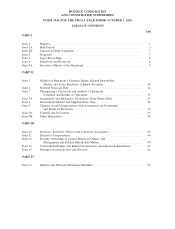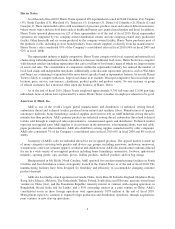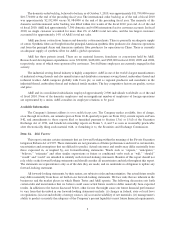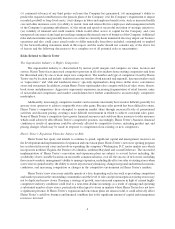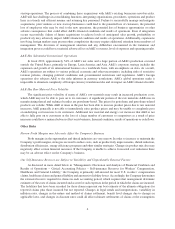Harris Teeter 2010 Annual Report Download - page 11
Download and view the complete annual report
Please find page 11 of the 2010 Harris Teeter annual report below. You can navigate through the pages in the report by either clicking on the pages listed below, or by using the keyword search tool below to find specific information within the annual report.start-up operations. The process of combining these acquisitions with A&E’s existing businesses involves risks.
A&E will face challenges in consolidating functions, integrating organizations, procedures, operations and product
lines in a timely and efficient manner and retaining key personnel. Failure to successfully manage and integrate
acquisitions, joint ventures or new start-up businesses could lead to the potential loss of customers, the potential
loss of employees who may be vital to the new operations, the potential loss of business opportunities or other
adverse consequences that could affect A&E’s financial condition and results of operations. Even if integration
occurs successfully, failure of future acquisitions to achieve levels of anticipated sales growth, profitability or
productivity may adversely impact A&E’s financial condition and results of operations. Additionally, expansions
involving foreign markets may present other complexities that may require additional attention from members of
management. The diversion of management attention and any difficulties encountered in the transition and
integration process could have a material adverse effect on A&E’s revenues, level of expenses and operating results.
A&E Has Substantial International Operations
In fiscal 2010, approximately 54% of A&E’s net sales and a large portion of A&E’s production occurred
outside the United States, primarily in Europe, Latin America and Asia. A&E’s corporate strategy includes the
expansion and growth of its international business on a worldwide basis, with an emphasis on Asia. As a result,
A&E’s operations are subject to various political, economic and other uncertainties, including risks of restrictive
taxation policies, changing political conditions and governmental restrictions and regulations. A&E’s foreign
operations also subjects A&E to the risks inherent in currency translations. A&E’s global operations make it
impossible to eliminate completely all foreign currency translation risks and its impact on A&E’s financial results.
A&E Has Raw Material Price Volatility
The significant price volatility of many of A&E’s raw materials may result in increased production costs,
which A&E may not be able to pass on to its customers. A significant portion of the raw materials A&E uses in
manufacturing thread and technical textiles are petroleum-based. The prices for petroleum and petroleum-related
products are volatile. While A&E at times in the past has been able to increase product prices due to raw material
increases, A&E generally is not able to immediately raise product prices and may be unable to completely pass
on underlying cost increases to its customers. Additional raw material and energy cost increases that A&E is not
able to fully pass on to customers or the loss of a large number of customers to competitors as a result of price
increases could have a material adverse effect on its business, financial condition, results of operations or cash flows.
Other Risks
Narrow Profit Margins may Adversely Affect the Company’s Business
Profit margins in the supermarket and thread industries are very narrow. In order to increase or maintain the
Company’s profit margins, strategies are used to reduce costs, such as productivity improvements, shrink reduction,
distribution efficiencies, energy efficiency programs and other similar strategies. Changes in product mix also may
negatively affect certain financial measures. If the Company is unable to achieve forecasted cost reductions there
may be an adverse effect on the Company’s business.
Our Self-Insurance Reserves are Subject to Variability and Unpredictable External Factors
As discussed in more detail below in “Management’s Discussion and Analysis of Financial Condition and
Results of Operations – Critical Accounting Policies – Self-insurance Reserves for Workers’ Compensation,
Healthcare and General Liability,” the Company is primarily self-insured for most U.S. workers’ compensation
claims, healthcare claims and general liability and automotive liability losses.Accordingly, the Company determines
the estimated reserve required for claims in each accounting period, which requires that management determine
estimates of the costs of claims incurred and accrue for such expenses in the period in which the claims are incurred.
The liabilities that have been recorded for these claims represent our best estimate of the ultimate obligations for
reported claims plus those incurred but not reported. Changes in legal trends and interpretations, variability in
inflation rates, changes in the nature and method of claims settlement, benefit level changes due to changes in
applicable laws, and changes in discount rates could all affect ultimate settlements of claims or the assumptions
6





